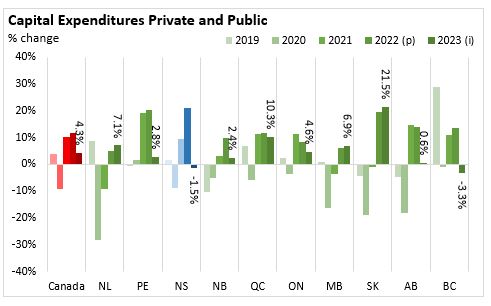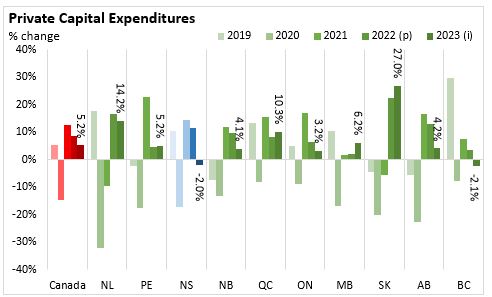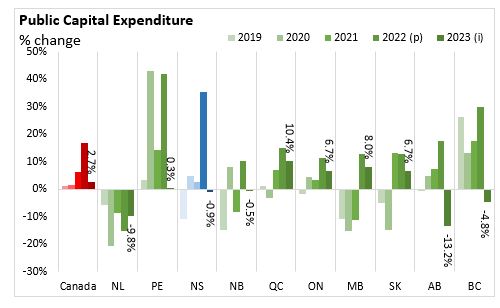The Economics and Statistics Division maintains archives of previous publications for accountability purposes, but makes no updates to keep these documents current with the latest data revisions from Statistics Canada. As a result, information in older documents may not be accurate. Please exercise caution when referring to older documents. For the latest information and historical data, please contact the individual listed to the right.
<--- Return to Archive
For additional information relating to this article, please contact:
February 28, 2023CAPITAL AND REPAIR EXPENDITURES SURVEY, 2022 (PRELIMINARY) AND 2023 (INTENTIONS) Statistics Canada has released preliminary estimates for 2022 and intentions for 2023 from the annual survey of capital expenditures for non-residential construction and machinery and equipment. The Capital and Repair Expenditures Survey is based on a sample survey of 27,000 private and public organizations. The survey on intentions for 2023 was conducted from September 2022 to January 2023.
Preliminary estimates on Nova Scotia's capital expenditures for 2022 were estimated at $5,135.2 million, a gain of 21.1% (+$896.3 million) compared to 2021.
Capital expenditures include both new non-residential capital construction and machinery and equipment spending. Capital construction in 2022 for Nova Scotia increased 27.5% to $3,102.4 million. Private construction rose 15.7% and public construction increased 35.4% over 2021. Machinery and equipment was up 12.6% to $2,032.8 million in 2022, with increase in in public investment (+36.0%, +$81.0 million) and private investment (+9.3%, +$147.0 million).
Capital expenditure intentions for 2023 are for a modest decrease of 1.5% (-$77.7 million) to $5,057.5 million. Compared to 2022, private expenditure (-2.0%, -$57.1 million) is expected to decrease with a decline in private machinery and equipment spending (-5.3%, -$91.7 million) offsetting an increase in private capital construction (+3.0%, +$34.5 million). Public capital expenditures intentions are for a decline of 0.9% (-$20.6 million) as a decrease in public machinery and equipment (-9.3%, -$28.3 million) offsets an increase in public capital construction (+0.4%, +$7.8 million)

Repair expenditures increased 10.7% in 2021 after a 17.7% decline in 2020. Repair expenditures increased for structures (+10.5%) and machinery and equipment (10.9%). Repair expenditures increased in the private sector (+14.9%) and the public sector (+3.2%) in 2021.

On an industry basis for Nova Scotia, the $896 million increase in capital expenditures for 2022 was due largely to increases in:
- Utilities (+$195 million)
- Public administration (+$288 million)
- Education (+$145 million)
- Transportation and warehousing (+$94 million)
- Health care and social assistance (+$93 million)
- Agriculture, forestry, fishing and hunting (+$82 million)
the notable decreases in capital expenditures in 2022 occurred for:
- real estate, rental and leasing (-$53 million)
- retail trade (-$20 million)

[Chart corrected from previous version that did not display the 2023 data]
For 2023, total capital expenditures are expected to decrease 1.5% or $78 million for Nova Scotia, with notable decreases for:
- Manufacturing (-$130 million)
- Agriculture, forestry, fishing and hunting (-$125 million)
and notable increases in capital expenditures for:
- Transportation and warehousing (+$106 million)
- Information and culture (+$40 million)
Canada is expected to see an increase of 4.3% in capital expenditures in 2023 following an increase of 11.7% in 2022 and 10.3% in 2021. Mining, quarry, and oil and gas extraction sector expected to regain top spot for capital spending with a 13.7% increase. Manufacturing is expected to increase 12.6% in 2023.
Nova Scotia (+21.1%) reported the largest gain in capital spending in 2022. Statistics Canada noted that for Nova Scotia the province and Halifax approved record capital budgets that drove a 30.4% increase in the public administration sector. Rebuilding from Hurricane Fiona is expected to increase construction activity in 2023 in Atlantic Canada, but some projects may face delays due to increase cost of construction and labour shortages.



Source; Non-residential capital and repair expenditures, 2023 (intentions)
<--- Return to Archive